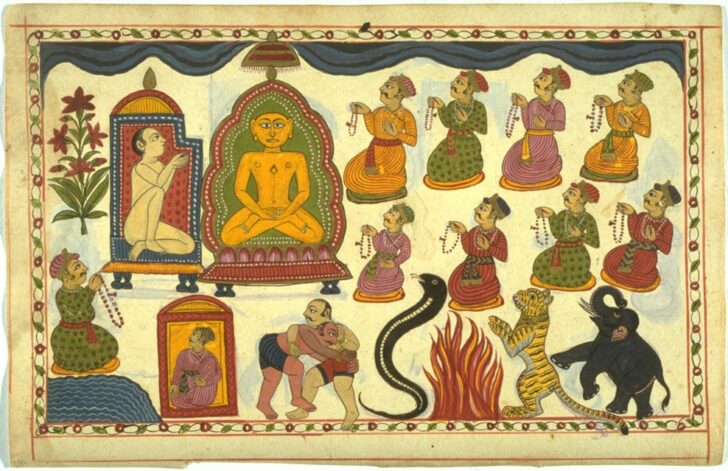Digambara Jain manuscript page: Jina venerated by a community of laymen
Artist Unknown, India, Rajasthan, Sirohi School

Description
In the Jain religion, book production reflects the integral relationship among the laity, monastic community, and the Jina, or enlightened Jain teacher. The dedication of sacred books for shrines is required of devotees, and while commissioning a book fulfills the lay obligation of charity, beholding a book helps the individual achieve the proper mental state for spiritual guidance. It was customary for a lay donor to commission a copy of a text for presentation to his spiritual teacher and ultimately to the temple library. Over the centuries, monastic libraries received great quantities of texts, which were employed in the instruction of monks and nuns, who were themselves discouraged from practicing the art of painting: one text expressly warns of the power of painting to arouse sensual feelings.
In these colorful pages, both the golden-hued Jina seated on a simple throne and the monk who venerates him are naked, identifying them as Digambara (sky-clad) Jina. On one page, they are shown receiving veneration from the laity (including princes), animals, plants, and even fire and water. On another, a prince is venerating the Jina in the midst of a battle.
Winter 2011 Gallery Rotation
Jina and battle scene from a Digambara Jain manuscript
India, Rajasthan, Sirohi
18th century
Ink, opaque watercolor, and gold on paper
Gift of Dr. and Mrs. Leo S. Figiel and Dr. and Mrs. Steven J. Figiel, 1975/2.168
Jina and battle scene from a Digambara Jain manuscript
India, Rajasthan, Sirohi
18th century
Ink, opaque watercolor, and gold on paper
Gift of Dr. and Mrs. Leo S. Figiel and Dr. and Mrs. Steven J. Figiel, 1975/2.169
In the Jain religion, book production reflects the integral relationship among the laity, monastic community, and the Jina, or enlightened Jain teacher. The dedication of sacred books for shrines is required of devotees, and while commissioning a book fulfills the lay obligation of charity, beholding a book helps the individual achieve the proper mental state for spiritual guidance. It was customary for a lay donor to commission a copy of a text for presentation to his spiritual teacher and ultimately to the temple library. Over the centuries, monastic libraries received great quantities of texts, which were employed in the instruction of monks and nuns, who were themselves discouraged from practicing the art of painting: one text expressly warns of the power of painting to arouse sensual feelings.
In these colorful pages, both the golden-hued Jina seated on a simple throne and the monk who venerates him are naked, identifying them as Digambara (sky-clad) Jina. On one page, they are shown receiving veneration from the laity (including princes), animals, plants, and even fire and water. On another, a prince is venerating the Jina in the midst of a battle.
Subject Matter:
In the Jain religion, book production reflects the integral relationship among the laity, monastic community, and the Jina, or enlightened Jain teacher. The dedication of sacred books for shrines is required of devotees, and while commissioning a book fulfills the lay obligation of charity, beholding a book helps the individual achieve the proper mental state for spiritual guidance. It was customary for a lay donor to commission a copy of a text for presentation to his spiritual teacher and ultimately to the temple library.
Physical Description:
Eight worshippers sit to the right of a sky-clad (nude) Jina and monk. They each raise beads in their hands. Below them a struggle is depicted. Two men in shorts wrestle, while a snake, tiger, and elephant rera up beside a fire.
Usage Rights:
If you are interested in using an image for a publication, please visit https://umma.umich.edu/request-image/ for more information and to fill out the online Image Rights and Reproductions Request Form.